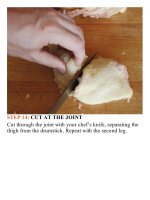The food lab better home cooking through science ( PDFDrive ) 366
Bạn đang xem bản rút gọn của tài liệu. Xem và tải ngay bản đầy đủ của tài liệu tại đây (82.89 KB, 2 trang )
evaporation,right?
The principle demonstrated by my test was first
observed by Johann Gottlob Leidenfrost, an
eighteenth-centuryGermandoctor.Turnsoutthatif
you give a drop of water on a pan enough energy,
the steam that it produces will be pressed out so
forcefully that it will actually lift the water droplet
clearoffthesurfaceofthepan.Becausethewateris
no longer in direct contact with the pan and is
insulated by this layer of steam, the transfer of
energybetweenthepanandthewaterbecomesquite
inefficient, so the water takes a long time to
evaporate.
The very center of this skillet is still relatively
cool, resulting in water that just bubbles as it sits
there.Theedges,however,arehotenoughtoinduce
the Leidenfrost effect, causing the entire blob of
water to form a cohesive unit that elevates itself
abovethesurfaceofthepan.
Here’s a closer look at a Leidenfrost-ified water
droplet:
This effect can be very useful in the kitchen as a
meansforjudginghowhotapanisifyoudon’town
an exceedingly sexy infrared instant-read
thermometer like I do. Drop a bead of water on a
pan while heating it. If it stays on the surface and
evaporatesrapidly,yourpanisunder350°Forso—
a suboptimal temperature for most sautéing and
searing.IfthepanishotenoughfortheLeidenfrost
effect to kick in, the water will form distinct drops
that skid and scoot over the surface of the metal,
taking quite a while to evaporate. Your pan is hot
enoughtocookin.









